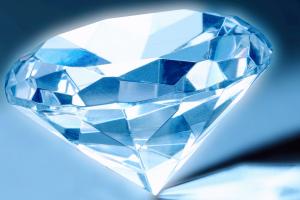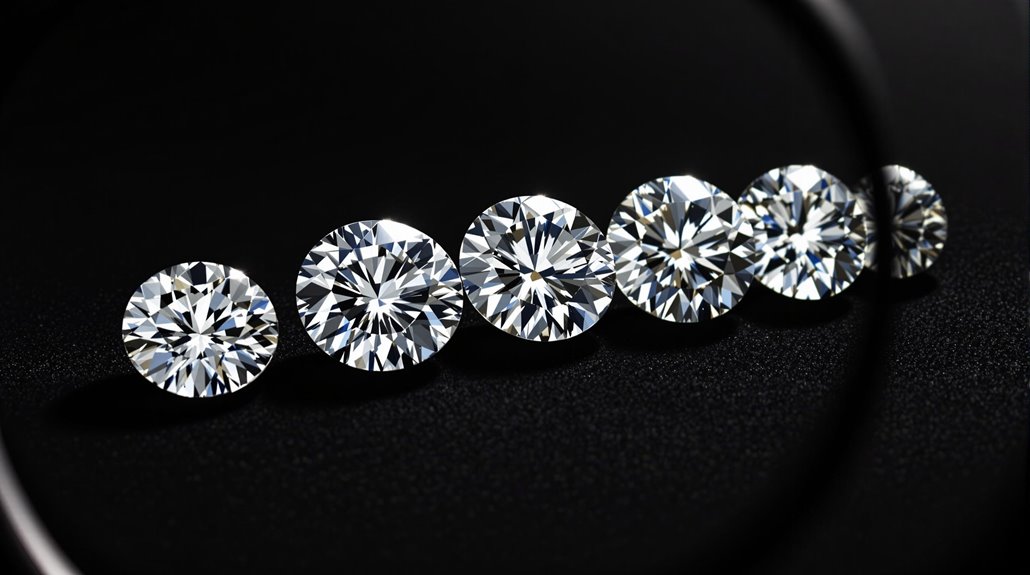Article Contents
- 1 Frequently Asked Questions
- 1.1 How Does Lighting Affect the Visibility of Inclusions in Diamonds?
- 1.2 Can Clarity Grades Improve or Worsen Over Time?
- 1.3 Do Lab-Grown Diamonds Follow the Same Clarity Grading Scale?
- 1.4 Which Clarity Grades Are Best for Colored Diamonds?
- 1.5 Does the Shape of a Diamond Impact Its Apparent Clarity?
Within the sphere of diamond clarity grading, the sweet spot typically lies within the VS (Very Slightly Included) to SI (Slightly Included) range, where value meets visual appeal. These grades offer an optimal balance between quality and cost-effectiveness, as their inclusions remain virtually invisible to the naked eye. Although VVS and Flawless grades command premium prices, savvy collectors recognize that VS and SI diamonds deliver exceptional beauty at more accessible price points. The subtleties of clarity grading reveal fascinating observations into each diamond's unique character.
In the intricate world of diamond evaluation, clarity grades serve as the definitive measure of a diamond's internal and external purity. The expedition to determine a diamond's clarity involves thorough examination by skilled graders who employ sophisticated instruments and established clarity factors to assess these precious stones. Through standardized grading methods developed by the Gemological Institute of America (GIA), each diamond undergoes careful scrutiny under 10× magnification, revealing its unique characteristics and eventually determining its place on the prestigious clarity scale. Meticulous documentation of each diamond's characteristics ensures accuracy and consistency in the grading process.
The clarity grading spectrum spans from the exceptional Flawless (FL) grade to the more accessible Included (I3) category, with most diamonds naturally falling into the Very Slightly (VS) or Slightly Included (SI) ranges. True Flawless diamonds remain extraordinarily rare, as even these magnificent specimens may reveal minute characteristics under strong magnification. The presence of inclusions and blemishes, whether internal or external, guides the grading process and influences a diamond's final classification. These distinctive marks are essentially unique birthmarks from formation under intense heat and pressure. Only less than one percent of all diamonds achieve the coveted Flawless grade, making them highly valuable in the market.
Professional graders employ specialized equipment, including binocular stereo microscopes with variable magnification and lighting alternatives, to conduct their assessments. Using the standardized GIA clarity scale, graders can ensure consistency in their evaluations worldwide. Each diamond is carefully rotated and examined through every facet, with graders noting the size, nature, position, and visibility of any clarity characteristics. This detailed analysis requires the diamond to be evaluated loose, confirming no mounting obscures potential inclusions or blemishes.
The Very Very Slightly Included (VVS) and Very Slightly Included (VS) categories represent diamonds of exceptional quality, where inclusions range from extremely difficult to somewhat challenging to detect, even for experienced graders. These prestigious grades often appeal to discerning collectors who appreciate subtle perfection as they maintain practical value considerations.
The Slightly Included (SI) category offers an attractive balance of quality and accessibility, featuring inclusions that, although visible under magnification, rarely affect the diamond's beauty to the naked eye.
The art of clarity grading encompasses more than mere identification of characteristics; it requires a holistic assessment of how these features interact with the diamond's overall appearance. Graders consider the cumulative impact of all clarity factors, focusing particularly on the most prominent grade-setting inclusions while contextualizing less significant ones.
This all-encompassing approach guarantees that each diamond receives its appropriate place within the established clarity hierarchy, providing collectors and consumers with reliable guidance for their acquisitions. The clarity grade becomes a fundamental component in the diamond's identity, influencing both its value and its desirability in the luxury market.
Frequently Asked Questions
How Does Lighting Affect the Visibility of Inclusions in Diamonds?
Different lighting techniques significantly influence inclusion visibility in diamonds, with side and top lighting making inclusions appear lighter, whereas bottom lighting can make them appear darker or more prominent.
Can Clarity Grades Improve or Worsen Over Time?
Diamond clarity grades remain stable as internal inclusions never change naturally. Whereas external wear may occur, these clarity fluctuations don't affect official grading consistency from certification institutions.
Do Lab-Grown Diamonds Follow the Same Clarity Grading Scale?
Whether natural or lab-grown, diamonds share identical clarity grading scales. In spite of unique lab grown diamond characteristics in their inclusions, both types follow standardized GIA and IGI clarity evaluation systems.
Which Clarity Grades Are Best for Colored Diamonds?
For colored diamonds, the ideal clarity range spans from VVS to VS grades, offering optimal balance between quality and value during guaranteeing minimal visible inclusions under typical viewing conditions.
Does the Shape of a Diamond Impact Its Apparent Clarity?
Diamond shapes significantly influence inclusion visibility. Brilliant cuts like rounds masterfully conceal imperfections, whereas step cuts such as emeralds reveal even tiny flaws with crystal-clear transparency.

